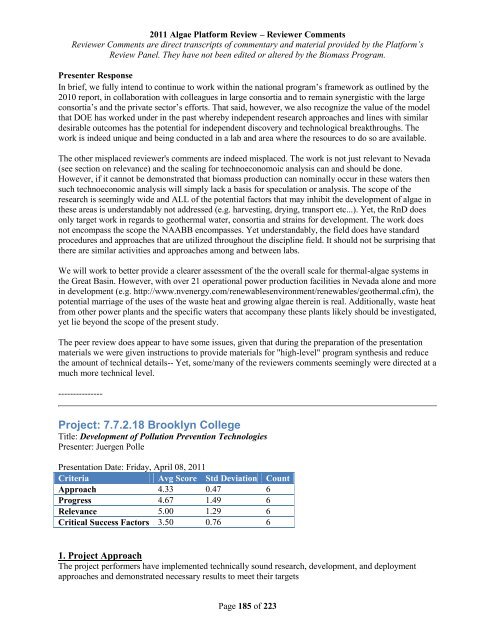Reviewer Comments - EERE
Reviewer Comments - EERE
Reviewer Comments - EERE
Create successful ePaper yourself
Turn your PDF publications into a flip-book with our unique Google optimized e-Paper software.
2011 Algae Platform Review – <strong>Reviewer</strong> <strong>Comments</strong><br />
<strong>Reviewer</strong> <strong>Comments</strong> are direct transcripts of commentary and material provided by the Platform’s<br />
Review Panel. They have not been edited or altered by the Biomass Program.<br />
Presenter Response<br />
In brief, we fully intend to continue to work within the national program’s framework as outlined by the<br />
2010 report, in collaboration with colleagues in large consortia and to remain synergistic with the large<br />
consortia’s and the private sector’s efforts. That said, however, we also recognize the value of the model<br />
that DOE has worked under in the past whereby independent research approaches and lines with similar<br />
desirable outcomes has the potential for independent discovery and technological breakthroughs. The<br />
work is indeed unique and being conducted in a lab and area where the resources to do so are available.<br />
The other misplaced reviewer's comments are indeed misplaced. The work is not just relevant to Nevada<br />
(see section on relevance) and the scaling for technoeconomoic analysis can and should be done.<br />
However, if it cannot be demonstrated that biomass production can nominally occur in these waters then<br />
such technoeconomic analysis will simply lack a basis for speculation or analysis. The scope of the<br />
research is seemingly wide and ALL of the potential factors that may inhibit the development of algae in<br />
these areas is understandably not addressed (e.g. harvesting, drying, transport etc...). Yet, the RnD does<br />
only target work in regards to geothermal water, consortia and strains for development. The work does<br />
not encompass the scope the NAABB encompasses. Yet understandably, the field does have standard<br />
procedures and approaches that are utilized throughout the discipline field. It should not be surprising that<br />
there are similar activities and approaches among and between labs.<br />
We will work to better provide a clearer assessment of the the overall scale for thermal-algae systems in<br />
the Great Basin. However, with over 21 operational power production facilities in Nevada alone and more<br />
in development (e.g. http://www.nvenergy.com/renewablesenvironment/renewables/geothermal.cfm), the<br />
potential marriage of the uses of the waste heat and growing algae therein is real. Additionally, waste heat<br />
from other power plants and the specific waters that accompany these plants likely should be investigated,<br />
yet lie beyond the scope of the present study.<br />
The peer review does appear to have some issues, given that during the preparation of the presentation<br />
materials we were given instructions to provide materials for "high-level" program synthesis and reduce<br />
the amount of technical details-- Yet, some/many of the reviewers comments seemingly were directed at a<br />
much more technical level.<br />
---------------<br />
Project: 7.7.2.18 Brooklyn College<br />
Title: Development of Pollution Prevention Technologies<br />
Presenter: Juergen Polle<br />
Presentation Date: Friday, April 08, 2011<br />
Criteria Avg Score Std Deviation Count<br />
Approach 4.33 0.47 6<br />
Progress 4.67 1.49 6<br />
Relevance 5.00 1.29 6<br />
Critical Success Factors 3.50 0.76 6<br />
1. Project Approach<br />
The project performers have implemented technically sound research, development, and deployment<br />
approaches and demonstrated necessary results to meet their targets<br />
Page 185 of 223




